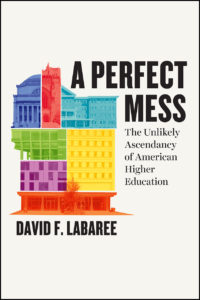
Image from the University of Chicago Press
In A Perfect Mess: The Unlikely Ascendancy of American Higher Education, David F. Labaree argues that American higher education became the world’s premiere “system” because of its chaotic start, entrepreneurial spirit, and general autonomy.
After describing some elements of American higher education, Labaree gives a two-part history of colleges and universities in the United States. The early days were not promising: curricula was often narrow, teachers were ill-prepared, and academic rigor was nearly totally absent. Moreover, colleges were often formed for some reason other than education itself—motivations included promoting a particular religious denomination, bringing culture to a “backwater” town, or increasing property values in newly settled areas. Chronically underfunded, these colleges were scrappy institutions always looking for new ways to please their students, whose tuition footed much of the bill.
Around 1880, however, the situation changed, as American institutions began creating rigorous graduate programs based on the German university model. Eventually, federal research funding as part of the Cold War leads to the “golden age” of American Universities, which Labaree dates from the G.I. Bill of 1944 to the fall of the Berlin Wall in 1989.
When Labaree talks about entrepreneurial spirit, he is speaking about institutions and faculty, but especially students, who he labels “consumers.” While those of us who believe in education for education’s sake may blanch at the term, Labaree has a very real point—most students attend college for a reason other than strict enlightenment. As Labaree writes:
The consumers [students] saw the college as useful in a number of ways: as a medium for preserving social advantage and avoiding downward mobility; as a place to have a good time, enjoy an easy transition to adulthood, pick up some social skills, and meet a spouse; even, sometimes, as a place to learn.
Concerning autonomy, Labaree notes that American universities, even “public” universities, are generally free of governmental oversight, particularly in comparison to European universities.
A Perfect Mess is a valuable book—it made me reconsider several aspects of higher education. Labaree is an entertaining and accessible writer, if something of a snob. His analysis of the hierarchy of higher education is made grating by his lofty perch at Stanford, and his breezy acceptance of the growing number of underpaid and overworked contingent faculty is off-putting. It is hard to argue with many of Labaree’s points, but one often wishes for a more critical analysis of the status quo than Labaree offers.
Finally, A Perfect Mess is a little too repetitious. It feels like a series of journal articles which have been edited, enlarged, and bound together—which the book essentially is, as noted in the acknowledgements.
Those flaws aside, I recommend A Perfect Mess to my friends in academia, or anyone interested in the American higher education system.